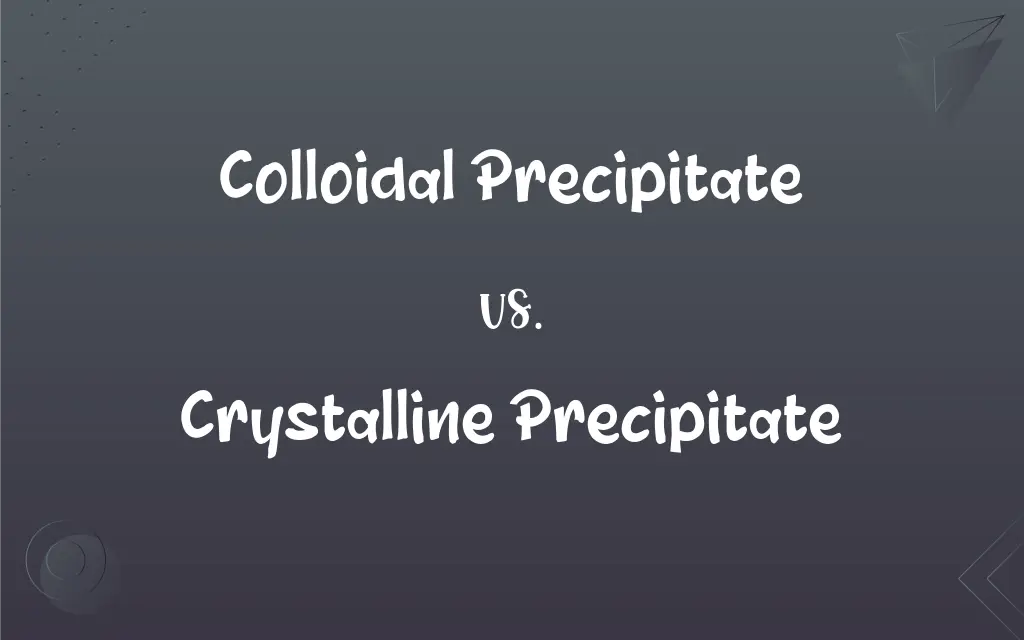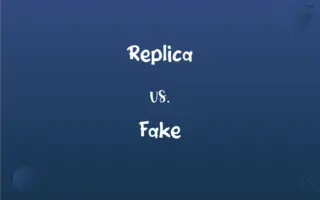Colloidal Precipitate vs. Crystalline Precipitate: What's the Difference?
Edited by Janet White || By Harlon Moss || Updated on October 18, 2023
Colloidal precipitates are fine, amorphous particles dispersed in a medium, while crystalline precipitates are solid, ordered structures that form distinct crystals.

Key Differences
Colloidal precipitates consist of fine particles that remain dispersed throughout a medium, often appearing cloudy or murky. On the other hand, crystalline precipitates involve the orderly arrangement of particles, leading to the formation of clear, distinguishable crystals.
Colloidal precipitates usually have a gel-like, amorphous appearance, making the solution look cloudy. Conversely, crystalline precipitates are more defined, forming solid structures that can often be seen settling at the bottom of a solution.
The particles in a colloidal precipitate are typically much smaller than those in a crystalline precipitate. This size difference accounts for the dispersed, cloudy nature of colloids versus the clear, settled appearance of crystalline substances.
Colloidal precipitates, due to their fine particle nature, can easily be redispersed upon agitation. Crystalline precipitates, once formed, are generally more stable and less likely to redissolve without a change in conditions.
Colloidal precipitates find applications in areas like medicine, where drug delivery in colloidal form can be beneficial. Crystalline precipitates are more common in chemical laboratories and industries where pure substances are needed.
ADVERTISEMENT
Comparison Chart
Nature of Formation
Fine, dispersed particles.
Orderly, clear crystals.
Appearance and Texture
Cloudy, amorphous.
Clear, distinct crystals.
Particle Size
Typically smaller.
Larger, ordered structures.
Stability and Behavior
Easily redispersed.
Stable and less likely to redissolve.
Applications and Use
Medicine, drug delivery.
Chemical labs, industries for pure substances.
ADVERTISEMENT
Colloidal Precipitate and Crystalline Precipitate Definitions
Colloidal Precipitate
Particles that scatter light, causing the Tyndall effect.
The light beam was visible in the colloidal precipitate due to the scattering of light.
Crystalline Precipitate
A solid with a regular, repeating pattern.
The solution yielded a clear crystalline precipitate upon cooling.
Colloidal Precipitate
An unstable system which can be coagulated.
An electrolyte was added to coagulate the colloidal precipitate.
Crystalline Precipitate
Represents a pure substance with defined properties.
The crystalline precipitate had a defined melting point, indicating its purity.
Colloidal Precipitate
A dispersion of fine particles in a medium.
The reaction produced a cloudy colloidal precipitate in the test tube.
Crystalline Precipitate
Can be redissolved under certain conditions.
The crystalline precipitate redissolved upon heating the solution.
Colloidal Precipitate
A system where particles do not settle out.
Upon adding the reagent, a colloidal precipitate formed, making the solution appear murky.
Crystalline Precipitate
Often seen in chemical reactions as a product.
Adding the two solutions together produced a crystalline precipitate.
Colloidal Precipitate
Often formed in intermediate stages of reactions.
Before the final product crystallized, a colloidal precipitate was observed.
Crystalline Precipitate
Particles that settle out of a solution.
The crystalline precipitate was collected by filtration.
FAQs
What are some methods to purify crystalline precipitates?
Recrystallization is a common method to purify crystalline substances.
Can you see individual particles in a colloidal precipitate?
Typically, no. The particles in colloidal precipitates are too small to be seen individually.
Are crystalline precipitates easy to filter?
Yes, crystalline precipitates, due to their larger size, are typically easy to filter.
How can you differentiate between the two by just looking?
Crystalline precipitates are clear and settled, while colloidal ones are cloudy.
Can colloidal precipitates be turned into crystalline ones?
Yes, under certain conditions or with added reagents, colloids can coagulate to form crystals.
What causes the Tyndall effect in colloidal precipitates?
The fine particles in colloidal precipitates scatter light, causing the Tyndall effect.
What are the applications of colloidal precipitates?
They find uses in areas like medicine, drug delivery, and some manufacturing processes.
How stable is a colloidal precipitate?
It's relatively unstable and can be easily redispersed or coagulated.
Can a colloidal precipitate be separated by centrifugation?
Yes, centrifugation can be used to separate colloidal particles from a dispersion.
What is the main difference between colloidal and crystalline precipitates?
Colloidal precipitates are fine, dispersed particles, while crystalline precipitates form ordered crystals.
Why might a colloidal precipitate form in an old solution?
Over time, solute particles may aggregate, leading to colloidal formation.
Can both types of precipitates be redissolved?
Depending on the substance and conditions, both can potentially be redissolved.
How does a colloidal precipitate appear in solution?
A colloidal precipitate typically appears cloudy or murky.
Why are crystalline precipitates often preferred in labs?
Crystalline precipitates are often pure and easier to characterize and handle.
What determines the shape of a crystalline precipitate?
The molecular or ionic structure of the substance dictates the crystal shape.
Are crystalline precipitates always pure?
While they often represent a single substance, impurities can be trapped within them.
Why do some reactions produce colloidal precipitates and not crystalline ones?
It often depends on reaction conditions, concentrations, and the nature of the reacting species.
Can you determine the size of particles in a crystalline precipitate?
Often, microscopy or X-ray diffraction can be used to determine crystal size and structure.
Are colloidal precipitates seen in everyday life?
Yes, colloids like milk, fog, and some lotions are examples.
How can you prevent the formation of a crystalline precipitate in a solution?
Adjusting conditions like temperature or adding solvents can prevent crystal formation.
About Author
Written by
Harlon MossHarlon is a seasoned quality moderator and accomplished content writer for Difference Wiki. An alumnus of the prestigious University of California, he earned his degree in Computer Science. Leveraging his academic background, Harlon brings a meticulous and informed perspective to his work, ensuring content accuracy and excellence.
Edited by
Janet WhiteJanet White has been an esteemed writer and blogger for Difference Wiki. Holding a Master's degree in Science and Medical Journalism from the prestigious Boston University, she has consistently demonstrated her expertise and passion for her field. When she's not immersed in her work, Janet relishes her time exercising, delving into a good book, and cherishing moments with friends and family.
































































